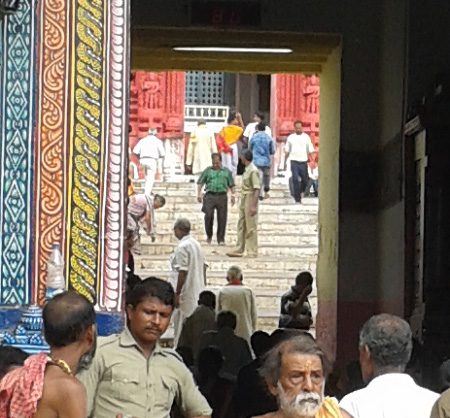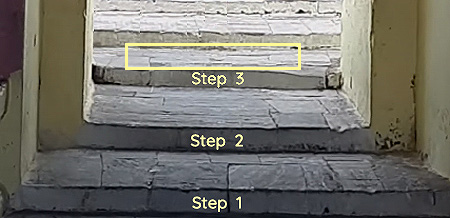BAISI PAHACHA OF JAGANNATH TEMPLE
Baisi Pahacha is a combination of two words 'Baisi' and 'Pahacha'. In local Odia language 'Baisi' means '22' and 'Pahacha' means 'Step', so 'Baisi Pahacha' means '22 Steps'. These 22 steps found at the 'Simha Dwara', the Lion's gate of Lord Jagannath temple, Puri. After entering the Lions' gate of the temple, devotees have to climb these 22 holy steps to reach the second inner gate (known as Baisi Pahacha Gumuta), after passing the second gate they will reach the courtyard from where they can get into the main temple to see Lord Jagannath.

According to belief, all sins of the devotees disappear who touch these steps even once, so devotees usually touch these 22 steps in hand while climbing them and also allowed their children to slowly roll over these steps from the top to the bottom in expectation of spiritual bliss. Pilgrims get a sense of fulfillment after putting a fleck of dust from the surface of these 22 steps on their forehead. Width of the middle 15 steps varies from 5 feet 10 inches to 6 feet 3 inches and the rise is 6 inches to 7 inches. The size of the remaining 7 steps is smaller in length and width. A black color stone known as 'Yama Shila' is engraved in the middle of the 3rd step. As per the belief, devotees must step on this stone while going up the steps because it frees themfrom 'Yama Danda' (Punishment of Yama, the God of death), ' but must not step on this stone on their way back since it will take away all the 'Punya' (values collected after visiting Lord Jagannath temple).

Various holy activities and rituals are performed on these 22 steps throughout the year, out of those 'Sradha' ritual is the most important one. Sradha is the annual Pinda Daana ritual of Hindus, a ritual in which food is offered to the ancestors, is usually performed on both sides of these 22 steps. The ancestral souls are believed to be satisfied by it. There is a small stone on the 7th step known as 'Pitru Shila'. Devotees offer Anna Mahaprasad, the holy rice of the temple that has been offered to Lord Jagannath, to this stone for feeding their ancestors to liberate their departed souls. It is also believed that during the annual car festival several Gods, Goddesses, Demi Gods, other heavenly bodies, the souls of the ancestors (near the Pitru Shila), Chitragupta and Yamadootas (near the Yama Sihla)came to these steps to see the grand Pahandi ceremony of Lord Jagannath. Madana Mohana, the representative idol of Lord Jagannath, offers Pinda Daana on these steps to his ancestors (Nanda and Yashoda, Devaki and Vasudeva, Koushalya and Dasaratha). Another ritual known as 'Badabadia Daka' (call the elders) is performed on these steps on the day of Deepavali. Devotees burn kaunria kathis (bundle of a particular kind of sticks which easily catch fire) on these steps on the Deepavali day to light up the path of their ancestral souls. The idols of Kasi Biswanath, Lord Rama, Nursingha and Ganesha have been installed on the southern side of the Baisipahacha.
Name of 22 Steps
|
Step Number
Name
Step 1
Tibra
Step 2
Kumudabati
Step 3
Mandaa
Step 4
Chandobati
Step 5
Dayabati
Step 6
Ranjani
Step 7
Ratika
Step 8
Roudraa
Step 9
Krodhaa
Step 10
Badrikaa
Step 11
Prasarini
Step 12
Brati
Step 13
Maarjani
Step 14
Khyati
Step 15
Raktaa
Step 16
Saandipani
Step 17
Aajaapani
Step 18
Madanti
Step 19
Rohini
Step 20
Ramyaa
Step 21
Ugraa
Step 22
Khyobhini
|
Significance of these 22 steps
There are various believes associated with the significance of these 22 steps.
First Significance:
One belief says each of these 22 steps has its own significance of the existence of the Universe. The significance is given below
- First Five Steps (from step 1 to 5): Describe all five Sense Organs, these are Eye, Ear, Nose, Tongue and Skin
- Second Five Steps (from step 6 to 10): Describe five Breathing (Prana), these are Up-breathing (prana), Down-breathing (apana), Back-breathing (Vyana), Out-breathing (Udana) and On-breathing (Samana). These five vital forces (Pancha Prana) breathe life into body
- Third Five Steps (from step 11 to 15): Describe the Inner Beauty, these are Looks (rupa), Aesthetics (rasa), Taste (swada), Smell (gandha) and Noise (sabda)
- Fourth Five Steps (from step 16 to 20): Describe the Pancha Mahabhutas, these are Earth, Water, Fire, Air and Space
- Twenty First Step (step 21) is for Wisdom
- Twenty Second Step (step 22) is for Ego
After crossing these Baisi Pahachas (22 Steps), devotees can see Lord Jagannath, the Lord of the Universe.
Second Significance:
Believers of Jainism hold these 22 steps to be a symbolic representation of their 22 Tirthankars. When a Jain devotee enters the Lion's gate and starts climbing the 22 steps, he touches each step in deep devotion and then touches his head as a mark of respect to the Trithankars of Jain religion.
Third Significance:
Some scholars say that these steps represent the 22 kinds of weaknesses and faults in human beings, so every devotee must sacrifice these 22 weaknesses by climbing these 22 steps before getting into the main temple to see Lord Jagannath.
Fourth Significance:
These 22 steps are symbols of Pancha Mahabhoot (5 five elements) + Panch Indriya (5 organs or senses) + Sada Ripu (6 enemies) + Three Gunas (3 qualities) + Mana (mind) + Buddhi (intellect) + Ahankar (egoism).
Fifth Significance:
The 3 deities (Lord Jagannath, Lord Balabhadra and Goddess Subhadra) X their 7 generations = 21 + Lord Jagannath who is beyond the Purusha = 22. This is the symbol of Baisi Pahacha.
Sixth Significance:
These 22 steps represent four Vedas and eighteen Puranas (4 Vedas + 18 Puranas = 22). One has to cross these 22 steps, so that Parambrahma Lord Jagannath will be available to him.